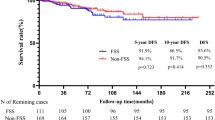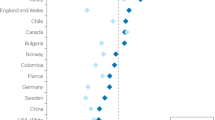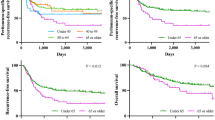Summary
This study examined histology-specific incidence trends of ovarian cancer in Canada, 1969–1993. The impact of age, period and cohort effects on these trends were studied by means of age-period-cohort analysis. Age-standardized incidence rates of serous, endometrioid, clear cell and germ cell tumours increased significantly and the rates of sex cord-stromal and other classified epithelial ovarian tumours decreased considerably. The rates of mucinous and NOS/unclassified tumours remained unchanged. Cohort effect has a major impact on incidence trends of serous, endometrioid, germ cell, sex cord-stromal and other classified epithelial ovarian tumours but no meaningful impact on trends of mucinous, clear cell, or NOS/unclassified ovarian tumours. Various cohort patterns by histology subtypes were observed: the risk of developing serious tumours increased markedly among birth cohorts of 1895–1930, stabilized thereafter and decreased among young cohorts of 1950–1960; the risk of germ cell tumours increased significantly among young cohorts of 1965–1980; and the risk of sex cord-stromal tumours dropped constantly among cohorts 1910–1950. Various period patterns by histology subtypes observed in this study suggested changes in histology classification criteria over the period. Further studies need to consider the various etiologies and the classification criteria changes according to histology subtypes.
Similar content being viewed by others
Article PDF
Change history
16 November 2011
This paper was modified 12 months after initial publication to switch to Creative Commons licence terms, as noted at publication
References
Adami, HO, Hsieh, CC, Lambe, M, Trichopoulos, D, Leon, D, Persson, I, Ekbom, A & Janson, PO (1994). Parity, age at first child, and risk of ovarian cancer. Lancet 344: 1250–1254.
Adami, HO, Bergstrom, R, Persson, I & Sparen, P (1990). The incidence of ovarian cancer in Sweden, 1960–1984. Am J Epidemiol 132: 446–452.
Albrektsen, G, Heuch, I & Kvale, G (1997). Full-term pregnancies and incidence of ovarian cancer of stromal and germ cell origin: a Norwegian prospective study. Br J Cancer 75: 767–770.
Amos, CI & Struewing, JP (1993). Genetic epidemiology of epithelial ovarian cancer. Cancer 71: 566–572.
Berg, JW (1982). Morphologic classification of human cancer. In: Cancer Epidemiology and Prevention 1st Edn, Schottenfeld D and Fraumeni J (eds), pp. 74–89. Oxford University Press: New York
Bjorge, T, Engeland, A, Hansen, S & Trope, CG (1997). Trends in the incidence of ovarian cancer and borderline tumours in Norway, 1954–1993. Int J Cancer 71: 780–786.
Chang, S & Risch, HA (1997). Perineal talc exposure and risk of ovarian carcinoma. Cancer 79: 2396–2401.
Clayton, D & Schifflers, E (1987a). Models for temporal variation in cancer rates, I. Age-period and age-cohort models. Stat Med 6: 449–467.
Clayton, D & Schifflers, E (1987b). Models for temporal variation in cancer rates, II. Age-period-cohort models. Stat Med 6: 468–481.
Cramer, DW, Devesa, SS & Welch, WR (1981). Trends in the incidence of endometrioid and clear cell cancers of the ovary in the United States. Am J Epidemiol 114: 201–208.
Dos Santos Silva, I & Swerdlow, AJ (1995). Recent trends in incidence of and mortality from breast, ovarian and endometrial cancers in England and Wales and their relation to changing fertility and oral contraceptive use. Br J Cancer 72: 485–492.
Ewertz, M & Kjaer, SK (1988). Ovarian cancer incidence and mortality in Denmark, 1943–1982. Int J Cancer 42: 690–696.
Farrow, DC & Rosenblatt, KA (1996). Ovarian Cancer. In: Cancer Epidemiology and Prevention, 2nd Edn, Schottenfeld D and Fraumeni J (eds). Oxford University Press: New York
Farrow, DC, Weiss, NS & Lyon, JL (1989). Association of obesity and ovarian cancer in a case-control study. Am J Epidemiol 129: 1300–1304.
Hankinson, SE, Hunter, DJ, Colditz, GA, Willet, WC, Stampfer, MJ, Rosner, B, Henneken, CH & Speizer, FE (1993). Tubal ligation, hysterectomy and risk of ovarian cancer: a prospective study. JAMA 270: 2813–2818.
Health and Welfare Canada (1993). The Making of the Canadian Cancer Registry: Cancer Incidence in Canada and its Regions, 1969 to 1988, pp. 10–19. Catalogue number C52-42/1992: Ottawa, Canada
Hempling, RE, Wong, C, Piver, MS, Natarajan, N & Mettlin, CJ (1997). Hormone replacement therapy as a risk factor to epithelial ovarian cancer: results of a case-control study. Obstet Gynecol 89: 1012–1016.
Horn-Ross, PL, Whittemore, AS, Harris, R & Itnyre, J the Collaborative Ovarian Cancer Group (1992). Characteristics relating to ovarian cancer risk: collaborative analysis of 12 US case-control studies. VI. Non-epithelial cancer among adults. Epidemiology 3: 490–495.
Koper, NP, Kiemeney, L, Massuger, L, Thomas, C, Schijf, C & Verbeek, A (1996). Ovarian cancer incidence (1989–1991) and mortality (1954–1993) in the Netherlands. Obstet Gynecol 88: 387–393.
Levi, F, Franceschi, S, La Vecchia, C, Ruzicka, J, Gloor, E & Randimbison, L (1993). Epidemiologic pathology of ovarian cancer from the Vaud Cancer Registry, Switzerland. Ann Oncol 4: 289–294.
Liu, S, Wen, SW, Mao, Y, Mery, L & Rouleau, J (1998). Birth cohort effects underlying the increasing testicular cancer incidence in Canada. Can J Public Health (in press)
Mosgaard, BJ, Lidegaard, O, Kiaer, SK, Schou, G & Andersen, AN (1997). Infertility, fertility drugs, and invasive ovarian cancer: a case-control study. Fertil Steril 67: 1005–1012.
National Cancer Institute of Canada (NCIC) (1998). Canadian Cancer Statistics 1998. NCIC: Toronto, Canada
Negri, E, Franceschi, S & Tzonou, A (1991). Pooled analysis of 3 European case-control studies. I. Reproductive factors and risk of epithelial ovarian cancer. Int J Cancer 49: 50–56.
On, L & Semenciw, R (1995). Disease Surveillance Sub-system. Environmental Risk Assessment and Case Surveillance Division, Cancer Bureau, Health Canada: Ottawa, Canada
Risch, HA, Marrett, LD & How, GR (1994a). Parity, contraception, infertility, and the risk of epithelial ovarian cancer. Am J Epidemiol 140: 585–597.
Risch, HA, Jain, M, Marrett, LD & Howe, GR (1994b). Dietary fat intake and risk of epithelial ovarian cancer. J Natl Cancer Inst 86: 1409–1415.
Risch, HA, Marrett, LD, Jain, M & Howe, GR (1996). Differences in risk factors for epithelial ovarian cancer by histologic type: results of a case-control study. Am J Epidemiol 144: 363–372.
Rosenberg, L, Palmer, JR, Zauber, AG, Strom, BL, Harlap, S & Shapiro, S (1994). A case-control study of oral contraceptive use and invasive epithelial ovarian cancer. Am J Epidemiol 139: 654–661.
Rosenblatt, KA & Thomas, DB (1996). Reduced risk of ovarian cancer in women with a tubal ligation or hysterectomy: The World Health Organization Collaborative Study of Neoplasia and Steroid Contraceptives. Cancer Epidemiol Biomarkers Prev 5: 993–995.
SAS Institute Inc. (1996). SAS/STAT Software: Changes and Enhancements, Release 611, pp. 383–490. SAS Institute Inc.: Cary, NC
Saskatchewan Health Department (1998). Utilization of contraceptives and hormone replacement therapy by Saskatchewan residents. Unpublished data. Saskatchewan Drug Plan and Extended Benefits. Regina, Saskatchewan, 1998
Siskind, V, Green, A, Bain, C & Purdie, D (1997). Breastfeeding, menopause, and epithelial ovarian cancer. Epidemiology 8: 188–191.
Tarone, RE & Chu, KC (1996). Evaluation of birth cohort patterns in population disease rates. Am J Epidemiol 143: 85–91.
Walker, AH, Ross, RK & Haile, RWC (1988). Hormonal factors and risk of ovarian germ cell cancer in young women. Br J Cancer 57: 418–422.
Weiss, NS, Homonchuk, T & Young, J (1977). Incidence of the histologic types of ovarian cancer: the US Third National Cancer Survey, 1969–1971. Gynecol Oncol 5: 161–167.
Whittemore, AS, Wu, ML & Paffenbarger, RS Jr (1988). Personal and environmental characteristics related to epithelial ovarian cancer. II. Exposures to talcum power, tobacco, alcohol, and coffee. Am J Epidemiol 128: 1228–1240.
Whittemore, AS, Harris, R & Itnyre, J the Collaborative Ovarian Cancer Group (1992). Characteristics relating to ovarian cancer risk: Collaborative analysis of 12 US case-control studies. II. Invasive epithelial ovarian cancers in white women. Am J Epidemiol 136: 1184–1203.
World Health Organization (1977). International Classification of Diseases, 1975 Revision, Vols 1 and 2. WHO: Geneva
World Health Organization (1976). International Classification of Diseases for Oncology. WHO: Geneva
Zhang, J (1998). Incidence Rates for Hysterectomy and Tubal Ligation in Canada and Provinces, 1970–1993. Unpublished data, Cancer Bureau, Health Canada: Ottawa, Canada
Author information
Authors and Affiliations
Rights and permissions
From twelve months after its original publication, this work is licensed under the Creative Commons Attribution-NonCommercial-Share Alike 3.0 Unported License. To view a copy of this license, visit http://creativecommons.org/licenses/by-nc-sa/3.0/
About this article
Cite this article
Zhang, J., Ugnat, AM., Clarke, K. et al. Ovarian cancer histology-specific incidence trends in Canada 1969–1993: age-period-cohort analyses. Br J Cancer 81, 152–158 (1999). https://doi.org/10.1038/sj.bjc.6690665
Received:
Revised:
Accepted:
Published:
Issue date:
DOI: https://doi.org/10.1038/sj.bjc.6690665



